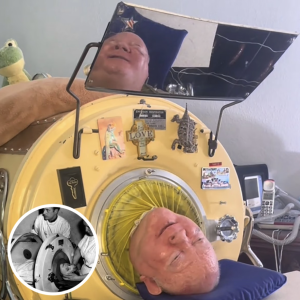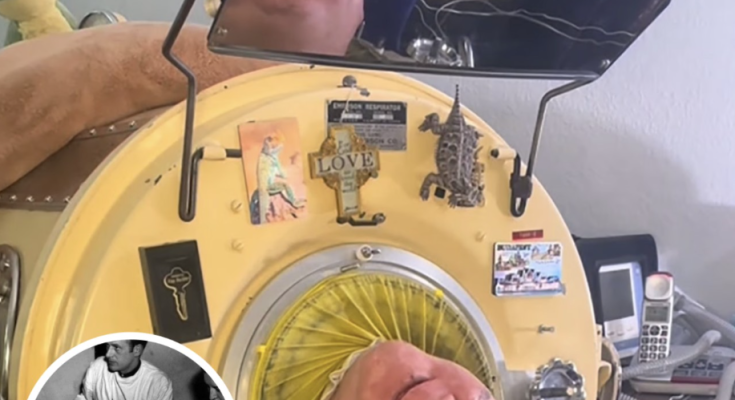 For most people, the idea of spending even a single day trapped inside a massive, humming metal cylinder is unimaginable. Yet for Paul Alexander, that was life—day after day, decade after decade—for an astonishing 70 years. Known as “The Man in the Iron Lung,” Alexander’s story was one of both unimaginable hardship and extraordinary resilience. This week, news broke that he had passed away, bringing to a close one of the most remarkable medical survival stories in modern history.
For most people, the idea of spending even a single day trapped inside a massive, humming metal cylinder is unimaginable. Yet for Paul Alexander, that was life—day after day, decade after decade—for an astonishing 70 years. Known as “The Man in the Iron Lung,” Alexander’s story was one of both unimaginable hardship and extraordinary resilience. This week, news broke that he had passed away, bringing to a close one of the most remarkable medical survival stories in modern history.
A Childhood Shattered by Polio
Paul was just six years old in 1952 when polio swept through his hometown of Dallas, Texas. The disease—highly contagious and terrifyingly fast—was at its peak in the United States, crippling or killing thousands of children each year. One summer afternoon, Paul came home from playing outside and told his mother he wasn’t feeling well. Within days, he was feverish, struggling to breathe, and unable to move.
Doctors confirmed what the family feared: he had contracted poliomyelitis. In an era before vaccines had become widespread, the prognosis was grim. The virus had attacked his nervous system, paralyzing his diaphragm. Without the ability to breathe on his own, he was rushed into a hospital ward filled with what looked like giant metal tubes—the iron lungs.
Life Inside the Machine
The iron lung was a mechanical respirator that saved countless lives during the polio epidemics of the early 20th century. It worked by creating negative pressure around the patient’s body, forcing the lungs to expand and contract. Patients lay flat on their backs, with only their heads protruding from the machine.
For Paul, the iron lung was supposed to be temporary—just until he regained the ability to breathe on his own. But the paralysis was permanent. Days turned into weeks, then months. Eventually, it became clear that he would never leave the machine entirely.
For most people, that would have meant a life of total dependence. But Paul had other ideas.
Defying Expectations
Doctors doubted Paul would survive into adulthood. Yet he refused to be defined solely by his condition. Over the years, he learned to spend short periods outside the iron lung by using a technique called “frog breathing,” in which he swallowed air into his lungs using his throat muscles. This allowed him a bit of mobility, though he always had to return to the iron lung to rest and sleep.
Paul’s determination didn’t stop there. He graduated from high school—one of the first people in decades to do so without physically attending classes due to a disability of this scale. Then, remarkably, he earned a law degree, passing the bar and practicing as an attorney for many years.
A Life of Advocacy and Connection
Beyond his career, Paul became a passionate advocate for people with disabilities. He gave interviews, spoke at events, and shared his story with anyone willing to listen—not to inspire pity, but to challenge people’s perceptions of what a life worth living could look like.
“I’m not living in a machine,” he once said in an interview. “I’m living my life. The machine just helps me do that.”
In his later years, Paul embraced the internet as a way to connect with the world. Through videos and social media, he gained a following of people inspired by his humor, wisdom, and blunt honesty about life’s challenges.
The Loneliness and the Strength
Paul often spoke candidly about the mental strain of living in an iron lung. The isolation could be crushing—especially in the early years, when he spent months without seeing his family. But over time, he found ways to cultivate joy. Music became a comfort. Friends and caregivers became a lifeline. And his ability to work and advocate gave him a sense of purpose.
There were, of course, dark times—moments when the weight of his circumstances felt overwhelming. But his resilience seemed to grow in proportion to his challenges.
The Last of His Kind
By the time of his death, Paul was believed to be the last person in the United States still relying on an iron lung. Advances in medical technology, the widespread polio vaccine, and modern ventilators had rendered the machines obsolete. But Paul chose to keep his iron lung, which he nicknamed “Old Iron Sides,” because it worked for him and he trusted it completely.
The sight of the hulking, yellow-painted cylinder in his Dallas home was a time capsule from a bygone era—a reminder of a disease that once terrified the world and of the incredible medical strides made since.
A Peaceful Passing
According to those close to him, Paul passed away peacefully at the age of 78. Friends, caregivers, and followers from around the globe flooded social media with tributes. Many called him an inspiration, a living symbol of perseverance in the face of overwhelming odds. Others simply thanked him for teaching them to appreciate the small freedoms they often took for granted.
One longtime friend wrote, “Paul taught me that you can live a full life without being able to run, or even to breathe on your own. He showed us that freedom is about mindset, not circumstances.”
His Legacy
Paul Alexander’s life was more than a medical curiosity—it was a testament to human adaptability. He transformed what could have been an existence defined entirely by limitation into a life marked by achievement, humor, and deep connection. His story also serves as a historical reminder: diseases that feel distant today were, not long ago, everyday tragedies.
In a world still grappling with pandemics, his journey underscores the importance of vaccines, public health, and support for people with disabilities. And for those who knew him personally—or even just followed his story online—Paul leaves behind a challenge: to live fully, regardless of the obstacles you face.
A Final Word from Paul
In one of his last interviews, Paul was asked how he wanted to be remembered. He paused, smiled, and said:
“I want people to remember that I lived. Really lived. That I wasn’t my disease, and I wasn’t my machine. I was Paul.”
And now, with his passing, the hum of “Old Iron Sides” has gone silent. But the echoes of his life—his determination, his wit, and his unshakable spirit—will resonate for years to come.

